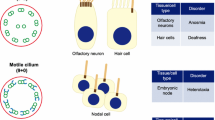Summary
Electron microscopy of 16 to 18 day old chick tracheas revealed that procentrioles are present near the basal ends of the recently matured centrioles and basal bodies of both ciliating and ciliated cells. Cylinders 0.1 μ in outside diameter in which densely staining walls and a central axial filament can often be detected, are present between the mature centrioles and these procentrioles. These cylinders although somewhat shorter are morphologically similar to those found earlier in the same cells in the center of procentriole clusters. So far, only one procentriole has been found in association with each cylinder and only one cylinder in association with each mature centriole or basal body. Procentrioles up to 0.18 μ in length including some with singlet microtubules in their walls have been detected. Serial sectioning indicated that in some cells up to 8% of the mature centrioles and basal bodies were associated with a cylinder and a distinct procentriole. If these procentrioles were to mature they could provide additional basal bodies for cilia after the initial wave of centriole assembly and maturation has been completed.
Similar content being viewed by others
References
Allen, R.D.: The morphogenesis of basal bodies and accessory structures of the cortex of the ciliated protozoanTetrahymena pyriformis. J. Cell Biol.40, 716–733 (1969).
Anderson, R.G.W., Brenner, R.M.: The formation of basal bodies (centrioles) in the rhesus monkey oviduct. J. Cell Biol.50, 10–34 (1971).
Brenner, R.M.: Renewal of oviduct cilia during the menstrual cycle of the rhesus monkey. Fertil. and Steril.20, 599–611 (1969).
Dippel, R.V.: The development of basal bodies inParamecium. Proc. nat. Acad. Sci. (Wash.)61, 461–468 (1968).
Dirksen, E.R.: Centriole morphogenesis in developing ciliated epithelium of the mouse oviduct. J. Cell Biol.51, 286–302 (1971).
Dirksen, E.R., Crocker, T.T.: Centriole replication in differentiating ciliated cells of mammalian respiratory epithelium. An electron microscopy study. J. Microscopie5, 629–644 (1966).
Frisch, D., Farbman, A.I.: Development of order during ciliogenesis. Anat. Rec.162, 221–232 (1968).
Fulton, D.: Centrioles. In: Origin and continuity of cell organelles (J. Reinert and H. Ursprung, eds.), p. 170–221. Berlin-Heidelberg-New York: Springer 1971.
Harven, E. de: The centriole and the mitotic spindle. In: Ultrastructure of biological systems (A.J. Dalton and F. Haguenau, eds.), p. 197–227. New York: Academic Press Inc. 1968.
Kalnins, V.I.: Ultrastructural observations on the development of cilia in the trochophore ofNereis limbata. Biol. Bull.133, 472 (1967).
Kalnins, V.I., Porter, K.R.: Centriole replication during ciliogenesis in the chick tracheal epithelium. Z. Zellforsch.100, 1–30 (1969).
Luft, J.H.: Improvements in epoxy resin embedding methods. J. biophys. biochem. Cytol.9, 409–411 (1961).
Mizukami, I., Gall, J.: Centriole replication. II. Sperm formation in the fernMarsilea and the cycadZamia. J. Cell Biol.29, 97–111 (1966).
Reynolds, E.S.: The use of lead citrate at high pH as an electron-opaque stain in electron microscopy. J. Cell Biol.17, 208–212 (1963).
Sabatini, D.D., Bensch, K., Barrnett, R.J.: Cytochemistry and electron microscopy. The preservation of cellular ultrastructure and enzymatic activity by aldehyde fixation. J. Cell Biol.17, 19–58 (1963).
Sorokin, S.P.: Centrioles and the formation of rudimentary cilia by fibroblasts and smooth muscle cells. J. Cell Biol.15, 363–377 (1962).
Sorokin, S.P.: Reconstructions of centriole formation and ciliogenesis in mammalian lungs. J. Cell Sci.3, 207–230 (1968).
Steinman, R.M.: An electron microscopic study of ciliogenesis in developing epidermis and trachea in the embryo ofXenopus. Amer. J. Anat.122, 19–55 (1968).
Watson, M.L.: Staining of tissue sections for electron microscopy with heavy metals. J. biophys. biochem. Cytol.4, 475–478 (1958).
Author information
Authors and Affiliations
Additional information
This investigation was supported by Medical Research Council of Canada Grant MA-3302. We would like to thank Mr. M. Wassmann for photography and Mrs. F. Smillie and Mrs. P. Middleton for typing the manuscript. Part of the work was done using the facilities of the Electron Microscopy Service Unit of the Faculty of Medicine, University of Toronto.
Rights and permissions
About this article
Cite this article
Kalnins, V.I., Chung, C.K. & Turnbull, C. Procentrioles in ciliating and ciliated cells of chick trachea. Z.Zellforsch 135, 461–471 (1972). https://doi.org/10.1007/BF00583430
Received:
Issue Date:
DOI: https://doi.org/10.1007/BF00583430




